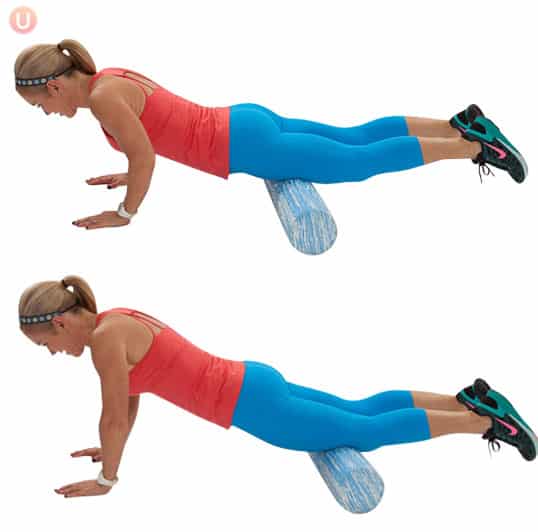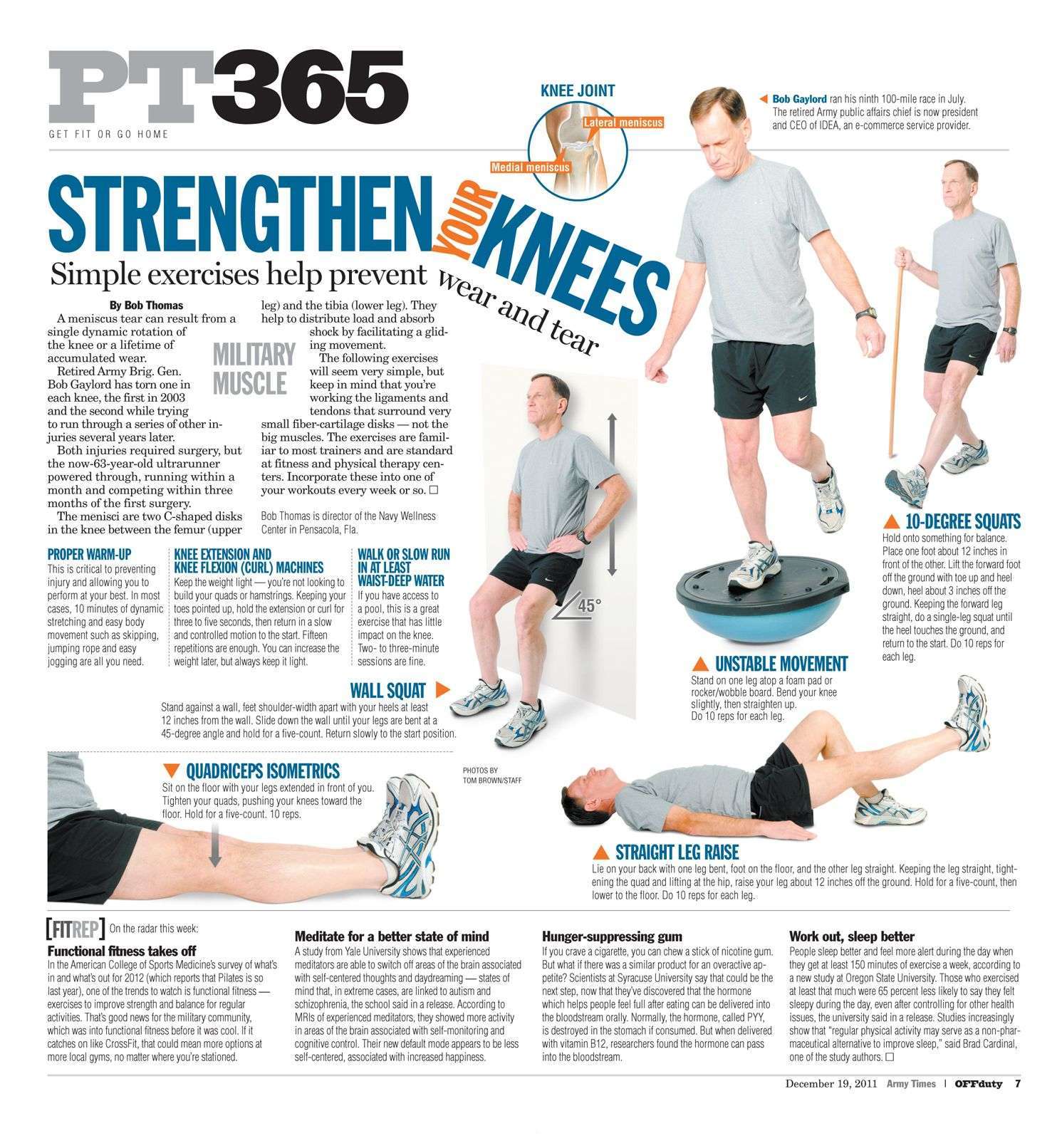You Are Not Challenging Your Range Of Motion
Strength is angular specific, meaning the range of motion used to strengthen a muscle in the gym is the range of motion that youll be able to express strength and safe movements outside the gym.
People only think about strengthening a muscle and improving knee health by adding weight, however if you can also increase the range of motion the knee can move pain free , you can also help alleviate knee pain in the long run.
Aim to train in a full range of motion, and over time, try to expand on that range of motion, even if it means you use less weight. This will help you not only decrease knee pain, but also strengthen the muscles of the leg throughout the entire range of motion.
Vmo Inner Range Quads
Depending on your injury, these exercises are done as soon as pain allows. In some cases, this may be within a day or so of injury after the acute stage has passed.
Position your knee in partial flexion by placing a towel or foam roller underneath. Straighten your knee and hold the contraction for approximately 5 seconds and relax.
Simple Exercises For Quad Strength
The exercises below can help you strengthen your quads. If you dont already exercise, its important to start out slowly so you wont injure yourself. Always warm up first with gentle stretching or by riding an exercise bike, if you have one, for about 10 minutes.
Perform one set of the following exercises, starting with three to four repetitions of each move and working up to 10. Then add a second and eventually a third set as you get stronger.
Working with a physical therapist is a great way to learn more exercises to strengthen your legs safely.
Read More: Aging With Arthritis
Read Also: What To Expect With Knee Replacement Surgery
How To Strengthen Your Quads After A Knee Replacement
After a knee replacement, it is important to focus on strengthening the quads. This can help to improve function and prevent future pain. There are a few different ways to strengthen the quads, including: 1. Doing quadriceps exercises. 2. Using a quadriceps machine at a gym. 3. Doing leg presses. 4. Going for walks or runs. 5. Taking part in physical therapy. Doing these exercises regularly can help to ensure that the quads are strong and can support the knee joint properly. This can help to improve long-term function and prevent pain.
It is common for the quadriceps tendon to be cut and sutures back together as it rises above the kneecap. You must engage your quad muscles in order to heal, recover, and reduce pain. To prevent excess scar tissue from forming, you must exercise your prescribed physical therapy exercises in the same manner as your prescribed exercises. Before you can lift your legs straight after a knee replacement, you may need to heal for several weeks. The straight leg raises are ideal for building strength in your quad, glute, and calf muscles. Additional exercises may be beneficial in improving your calf muscles and hamstrings.
When your knee swells up after you have surgery such as ACL surgery or total joint replacement, it becomes arthrogenic muscle inhibition, which results in quad activation failure. Because it shuts down normal neural stimulation to the muscles, your nervous system protects the knee joint from the strain of muscle movement.
Prone Straight Leg Raises

Lie on your stomach with your legs straight. Tighten the muscles in your bottom and the hamstring of one leg, and lift toward the ceiling. Hold 3-5 seconds, lower, and repeat. Do 10-15 lifts and switch sides. You can add ankle weights as you gain strength. You shouldnt feel back pain. If you do, limit how high you lift up. If it still hurts, stop and talk to your doctor.
Don’t Miss: Which Knee Brace To Buy
What Not To Do
- Do not let the back arch during the exercise.
- Do not jerk or bounce the leg or lift it above the knee on the bent leg.
- People who have osteoporosis or a back compression fracture should not perform this exercise.
Muscles involved: Hamstrings and gluteal muscles.
Squat Jumps Knee Strengthening Exercise
Use dumbbells if appropriate. This is an advanced exercise, be careful not to overdo it. With a slight bend in your knees, chest up, and feet hip-width apart, hold a pair of dumbbells with straight arms. Bend your knees to perform a squat. Then jump up explosively, landing softly. Aim for 2 sets of 8 reps.
Don’t Miss: Is Heat Or Ice Better For Arthritis Knee Pain
Isometric Workout For Muscle Strengthening To Reduce Knee Pain
I suggest performing these exercises on both legs, even though you may only have knee pain on one leg. This will allow for equal strengthening and could actually help support the knee even better.
Also, if you experience any pain, please stop performing the knee strengthening exercises and consult your doctor, physical therapist or trainer to make sure you are performing the exercises correctly. Take it slow. Over time, you will get stronger!
Beginning Workout
Quadriceps Stengthener
Lay on your back. Place a rolled up towel or a small foam roller beneath the knee. Activate the thigh muscles in order to straighten the knee and hold the contraction for 5 seconds. Release. Repeat 10 times on each side. This will strengthen the quadriceps.
Straight Leg Raise
Lay on your back. Stretch both legs out on the floor. Lift the right leg up to about 6 inches off the floor and hold the contraction for 10 seconds. Make sure to keep abs tight. It may help to place hands underneath you at the lower area of the back for support as you want to avoid arching. Make sure to engage those quadriceps! This will strengthen the quadriceps and your core. Repeat 5 times on each side.
Hip Adduction
Lay on your back on the floor. Bend knees keeping feet on the floor. Place a small pillow, lightweight ball or foam roller between the knees. Squeeze the legs towards the object you are holding and hold for 510 seconds. Release and repeat 1020 times. This will strengthen the inner thigh muscles.
Hip Raise
Quadriceps Weakness After Tka: What To Expect And How To Improve It
A patient with a quadriceps weakness will most likely experience this condition for the rest of his or her life following total knee arthroplasty . Muscle weakness following TKA usually occurs as a result of muscle inhibition caused by swelling and inflammation that occurs after the surgery. A quad tendon injury typically heals in 10 to 12 weeks, and it could take longer to fully recover. Why is my knee weak after I had a replacement surgery? Following surgery, the knee swells, which causes arthrogenic muscle inhibition, which prevents you from contracting your muscles despite no injury to the muscle or nerve. Researchers injected saltwater into the knee joints of volunteers several years ago, according to Dr. Keller. âI lost 50 percent of my muscle strength in an hour,â he said. As a result, there are ways to speed up muscle healing. Dr. Keller stated that physical therapy is recommended as soon as the surgery is completed. It also helps to improve strength and flexibility. Furthermore, wearing a knee brace may help to reduce swelling and inflammation. Despite the fact that thigh weakness is common after TKA, physical therapy and wearing a knee brace can help.
Also Check: Where Can I Buy Copper Fit Knee Brace
You Are Lifting Too Heavy Too Often
When it comes to knee pain, sometimes the pain is due to a loading issue rather than the particular exercise.
When you lift too heavy, the muscles may not be able to deal with the extra loading stress, which in turn will place more strain on the joints and connective tissues.
If you are using heavy loads all the time, there is always a risk that you will at some point let your form change and open yourself up to increased risks of injury or overuse injuries.
This is why having a program that modifies your workouts based on your performance is key. With Fitbod, your workouts are tailored to your goals, abilities, and week to week performance.
Anything Quad Exercise That Is Done With Heavy Weight And Hard Intensity
This is more of a training tip, but if you are lifting heavy weights and training to failure, and pushing through knee pain, just know you are walking on borrowed time.
If something hurts, causes knee joint pain, or swelling, the exercise itself may not be the issue, but rather your form and how much weight you are lifting or how fast you are doing a movement may be.
Also Check: When Will My Knee Replacement Stop Hurting
Is It Safe For Me To Exercise
Are you worried that working out could cause more knee damage or pain? As long as your doctor says its OK, the best thing you can do is to strengthen the muscles that support your knee and keep them flexible. Start slowly, and build up over time. Talk to your doctor about which specific exercises are good for you.
Exercises For Knee Oa Pain

Learn more about exercises that help with knee pain, promote knee function and reduce injury.
1. 6 Exercises for Knee OA Pain
2. Listen to Your Body
3. Mini Squat
4. Quad Stretch
5. Standing Back Leg Slide
6. Knee Strengthener Move 1
7. Knee Strengthener Move 2
8. Hamstring Stretch
9. Take Pressure Off Your Knees
During Pain Awareness Month in September and all year long, weve got you covered with unique pain management tools and resources you wont find anywhere else.
Physical Activity
You May Like: Why Does My Knee Hurt So Much
Why Do Quadriceps Exercises For Knee Pain
Quadriceps exercises for knee pain can make a massive difference in most cases of knee pain, particularly:
- Runners Knee: Anterior knee pain caused by a problem with kneecap movement
- Knee Tendonitis: Inflammation and degeneration of the knee tendons
- Knee Bursitis: Inflammation of the small sacs that sit between muscles, tendons and bone
- Knee Arthritis: Wear and tear of the knee cartilage and bones
- Quadriceps Strain: Tears in one or more of the quadriceps muscles
- Quads Tendon Rupture: Tear of the tendon attaching quads to kneecap
How Much Should I Do
As your muscles get stronger, you will be able to increase the number of repetitions of each of these knee strengthening exercises.
You will probably need to do knee strengthening exercises at least four times a week for about a month before you notice much change in your knee pain at which point you may also want to add in some knee stretches – it’s important to have enough strength before you start stretching else you can make things worse.
To find out how to exercise safely and effectively, visit the sections on How to Exercise Right and Getting the Best Results from your knee strengthening exercises.
When you feel ready, strengthen your muscles further by progressing on the intermediateand advancedknee strengthening exercises.
View of all these exercises
Don’t Miss: Is Kneecap Replaced In Total Knee Replacement
Icipants Included In The Review
Studies of participants with knee osteoarthritis were eligible for inclusion. Studies recruiting patients with osteoarthritis of other joints were included if the results for the knee were available separately. The participants in the aerobic exercise trials had a mean age between 69 and 70.1 years, whereas those in the strengthening exercise trials had a mean age between 61.9 and 73.7 years.
Machine Single Leg Extensions
With the machine single leg extension, you are able to build muscle and strength one leg at a time, which can be helpful when trying to address lower body training when one knee is more painful than the other.
Whether you are recovering from an injury or want to percent one, training the legs indledning can help correct muscle imbalances and address any muscle weaknesses.
Form Tip: Use less weight than you think, and add isometric holds at the top to train the quad directly, with less weight.
You May Like: Popping In Back Of Knee
What Can You Do For The Pain
Your plan will depend on your specific injury. Mild to moderate issues will often get better on their own. To speed the healing, you can:
- Rest your knee. Take a few days off from intense activity.
- Ice it to curb pain and swelling. Do it for 15 to 20 minutes every 3 to 4 hours. Keep doing it for 2 to 3 days or until the pain is gone.
- Compress your knee. Use an elastic bandage, straps, or sleeves to wrap the joint. It will keep down swelling or add support.
- Elevate your knee with a pillow under your heel when you’re sitting or lying down to cut down on swelling.
- Take anti-inflammatorymedications. Nonsteroidal anti-inflammatory drugs such as ibuprofen or naproxen will help with pain and swelling. Follow the instructions on the label. These drugs can have side effects, so you should only use them now and then unless your doctor says otherwise.
- Practice stretching and strengthening exercises if your doctor recommends them. You may want to do physical therapy, too.
Make an appointment with a doctor if you still have pain after 2 weeks of home treatment, if the knee becomes warm, or if you have fever along with a painful, swollen knee.
Some people with knee pain need more help. For instance, if you have bursitis, your doctor may need to draw out extra fluid from the bursa in your knee. If you have arthritis, you may need an occasional corticosteroid shot to settle down inflammation. And if you have a torn ligament or certain knee injuries, you may need surgery.
Questions Your Doctor May Ask
Your doctor will want to know as much as possible about whatâs going on with your knee. Be ready to answer questions such as:
Your answers will give your doctor clues about the cause of your pain. For instance, a popping or snapping sound may mean that you tore a ligament. If your pain is worse when you rest and your knee is stiff when you wake up, you could have a type of arthritis.
Your doctor will also ask about:
- Problems with any other joints
- Any knee injuries or surgeries youâve had
- Other health issues that might be causing the pain
A hip problem, for example, can cause you to walk awkwardly, which throws off alignment of your knees, causing pain. Also, pain from your hip can make your knee hurt.
Let your doctor know what youâve already tried to treat your knee pain, such as medicines, braces, and physical therapy.
Also Check: What Is The Most Common Knee Injury
Side Straight Leg Raise
This exercise targets your lateral hip muscles. Strengthening them, along with other hip muscles, helps keep your knee stable and can reduce pain as well. Give it a shot if you have a wobbly knee!
To do it:
- Bend the lower knee.
- With the other leg straight, raise it up until its aligned with your hip.
Repeat 5-15 times for up to 3 sets. To increase difficulty, hold the leg up for a few seconds.
Pro tips:
Place the hand of your upper arm flat on the floor for extra stability.
Also, if you have lateral knee pain that worsens with this exercise, its best to stop and move on to another movement the next.
You may want to get your knee checked, as 7 potential issues may be causing pain on the outside of the knee.
Reasons For Knee Pain

There are many common reasons for knee pain, but a 2015 study published in the journal Best Practice & Research Clinical Rheumatology indicates that most are work related or from past injuries. The study states that symptomatic knee osteoarthritis can be viewed as the end result of a molecular cascade that takes place after certain triggers occur and ultimately results in irreversible damage to the articular cartilage.
The study suggests that while there are multiple causes of knee OA, two have attracted particular attention over recent years: occupation-related knee OA and OA subsequent to a previous knee injury. Studies also report that knee OA is likely to become the eighth most important cause of disability in men and the fourth most important cause of disability in women according to the World Health Organization report on global burden of disease. Three major physical impairments such as knee pain, stiffness and decreased quadriceps strength are highly associated with knee OA and are believed to contribute to physical disability and progression of the disease.
In general, knee pain is typically caused by two things: arthritis or a sports related injury.
1. Arthritis
There are several forms of arthritis that affects the knees: osteoarthritis, rheumatoid arthritis, gout, reactive arthritis, lyme disease, lupus, ankylosing spondylitis, psoriatic arthritis and infectious arthritis.
2. Injury
Read Also: What Causes Blood Clots After Knee Surgery